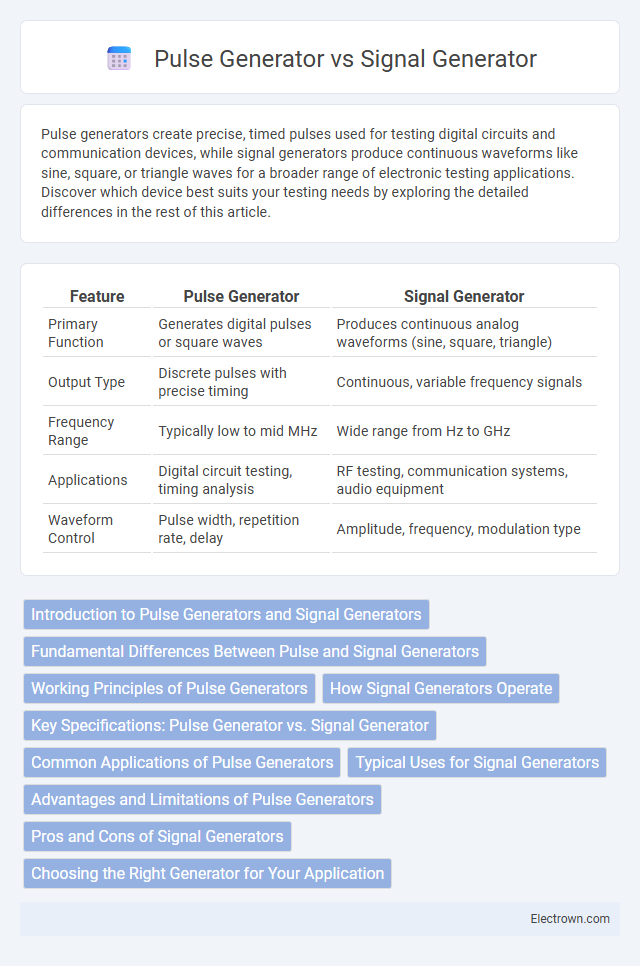Pulse generators create precise, timed pulses used for testing digital circuits and communication devices, while signal generators produce continuous waveforms like sine, square, or triangle waves for a broader range of electronic testing applications. Discover which device best suits your testing needs by exploring the detailed differences in the rest of this article.
Table of Comparison
| Feature | Pulse Generator | Signal Generator |
|---|---|---|
| Primary Function | Generates digital pulses or square waves | Produces continuous analog waveforms (sine, square, triangle) |
| Output Type | Discrete pulses with precise timing | Continuous, variable frequency signals |
| Frequency Range | Typically low to mid MHz | Wide range from Hz to GHz |
| Applications | Digital circuit testing, timing analysis | RF testing, communication systems, audio equipment |
| Waveform Control | Pulse width, repetition rate, delay | Amplitude, frequency, modulation type |
Introduction to Pulse Generators and Signal Generators
Pulse generators produce precise electrical pulses with defined amplitude, width, and repetition rate, essential for testing digital circuits and timing applications. Signal generators create continuous waveforms, such as sine, square, or triangle signals, used for analyzing and calibrating analog systems. Understanding the differences helps you select the right tool for specific electronic testing and development needs.
Fundamental Differences Between Pulse and Signal Generators
Pulse generators produce short bursts of electrical signals with precise timing and amplitude, primarily used for testing digital circuits and systems requiring time-domain analysis. Signal generators emit continuous waveforms such as sine, square, or triangular signals, essential for frequency-domain testing and modulation applications. The fundamental difference lies in pulse generators delivering transient, time-specific pulses, while signal generators provide steady, repeatable waveforms for broader frequency testing.
Working Principles of Pulse Generators
Pulse generators operate by producing electrical pulses of specific amplitude, duration, and frequency, often using timing circuits such as monostable multivibrators or digital logic components to control pulse width and repetition rate. These devices emit a series of short bursts of energy, enabling precise control over pulse timing, which is essential for testing digital circuits and simulating real-world signal conditions. Unlike continuous wave signal generators, pulse generators focus on generating transient, time-limited signals vital for applications requiring accurate timing analysis.
How Signal Generators Operate
Signal generators produce electronic signals with varying frequencies, amplitudes, and waveforms, allowing precise control for testing and calibration in electronic devices. They operate by creating a stable oscillation through a frequency synthesizer or direct digital synthesis (DDS), ensuring accuracy and flexibility for different applications. Your testing processes benefit from the signal generator's ability to produce consistent, repeatable signals tailored to specific requirements.
Key Specifications: Pulse Generator vs. Signal Generator
Pulse generators produce precise pulses with defined widths, amplitudes, and repetition rates, essential for testing digital circuits and timing applications. Signal generators create continuous waveforms such as sine, square, or triangular signals with adjustable frequency, amplitude, and modulation, widely used in communication system testing and signal analysis. Key specifications for pulse generators include rise/fall time, pulse width accuracy, and repetition rate, while signal generators prioritize frequency range, output power, and modulation capabilities.
Common Applications of Pulse Generators
Pulse generators are commonly used in digital circuit testing, radar systems, and communication equipment to produce precise, time-controlled pulses. Your ability to simulate clock signals, trigger events, and test switching behavior relies heavily on these devices. Unlike signal generators that produce continuous waveforms, pulse generators excel in applications requiring sharp, well-defined pulses for timing and control analysis.
Typical Uses for Signal Generators
Signal generators are commonly used in electronic testing and development to produce precise waveforms such as sine, square, and triangular signals for equipment calibration and troubleshooting. They play a crucial role in communications, enabling simulation of various signal conditions to test radios, receivers, and transmitters. Engineers rely on signal generators for validating circuit performance, frequency response, and modulation characteristics across a wide frequency range.
Advantages and Limitations of Pulse Generators
Pulse generators offer high precision in producing sharp, short-duration pulses essential for testing digital circuits, while their ability to generate repetitive waveforms enables detailed timing analysis. Limitations include restricted waveform variety compared to signal generators and potential challenges in handling complex modulation schemes. Your choice depends on whether precise pulse control or broader signal versatility is required for your application.
Pros and Cons of Signal Generators
Signal generators offer precise frequency range control and stable output, making them ideal for testing communication systems and electronic devices. However, their complexity and higher cost compared to pulse generators might limit their use in simpler or cost-sensitive applications. Your choice depends on whether you need broad frequency versatility or specific pulse characteristics for your testing requirements.
Choosing the Right Generator for Your Application
Pulse generators create precise, repetitive pulses ideal for digital circuit testing and timing analysis, while signal generators produce continuous waveforms suited for analog signal simulation and communication testing. Your choice depends on whether your application requires sharp, controlled pulses or a range of frequencies and modulation types for signal analysis. Opt for a pulse generator for timing-sensitive tasks and a signal generator when simulating complex waveform environments.
Pulse Generator vs Signal Generator Infographic

 electrown.com
electrown.com